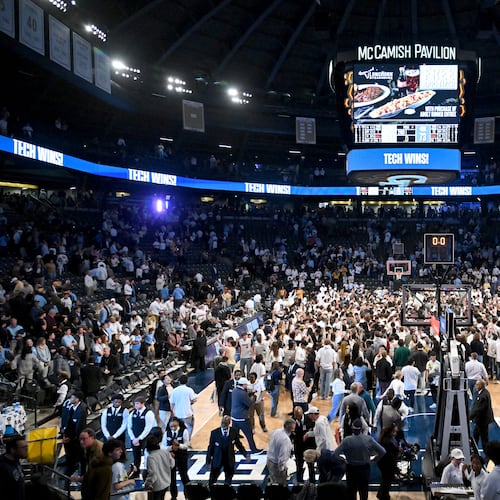When he lines up as a “3-technique” defensive tackle, Georgia Tech’s Ja’Quon Griffin trains his vision on the “V” of the collar of the jersey worn by the guard he is lined up against.
With his eyes on that spot, Griffin’s job is to move in step with the guard’s movement at the snap. If the guard moves left, Griffin’s eyes (and hands and feet) will go with him, and the V will give Griffin a target for his inside hand (the one closer to the center) with the outside hand on the guard’s outside shoulder to keep control of him.
“Our eyes and hands are going to go wherever the guard goes,” Griffin said last week following the Yellow Jackets’ spring-practice workout.
Griffin’s explanation may have been the sweetest melody to defensive line coach Larry Knight, whose overriding teaching point of spring practice has been for his players to keep their eyes focused on the right spots.
“Every play begins with sight,” Knight said. “When we have our eyes in the wrong place, our hands go to the wrong place. When our hands go to the wrong place, our feet go to the wrong place. When your feet go to the wrong place, you’re done. Play’s over for you.”
Attention to detail might be the priority that has received the most stress in coach Geoff Collins’ third spring practice, judging by comments from coaches and players. Consistency might be close behind. The two themes are intertwined in Knight’s emphasis on players’ learning to keep their eyes locked in on something as a specific spot on a jersey, play in and play out.
“The true sign of greatness is consistency,” Knight said. “If you’re not showing myself and (defensive ends/linebackers coach Marco Coleman) that consistency, you’ll be standing right next to us (on the sideline) holding that ‘Money Down’ sign. That’s the way it’s going to work.”
Among the defensive linemen whom Coleman and Knight oversee, there’s a large portion of players who have some playing and starting experience, but are still developing.
Among tackles, that includes Griffin, T.K. Chimedza, Djimon Brooks, Mike Lockhart, Akelo Stone and D’Quon Douse. Among ends, Jordan Domineck, Antonneous Clayton, Jared Ivey, Kyle Kennard and Sylvain Yondjouen form the core. (Yondjouen is still recovering from a season-ending injury and is not participating fully this spring.)
All of the aforementioned 11 have done enough to merit at least one start. But the most career games that any of the group has started is Brooks with 12. All have played five-plus games in at least one season (enough to go past the four-game limit to be able to redshirt), but only one has played more than two such seasons (Clayton, who had two of those years at Florida before transferring).
In short, it’s a group that has played meaningful snaps, but most have just not played many of them. Compare that with the offensive line, which has four players with more career starts than Brooks’ 12. (Both the offensive and defensive lines will add grad transfers with significant starting experience after their graduations, defensive end Keion White from Old Dominion and offensive tackle Kenneth Kirby from Norfolk State.)
But the accumulated playing time does give Knight the capacity to hold players to a higher standard.
“One of the things I can say is, ‘You have played meaningful snaps in football games,’ so they understand what the disappointment level is when they’re not executing things the right way,” Knight said. “Also, they understand that there’s somebody breathing down their neck that has experience that has played, that has proven themselves.”
“That’s the competition,” Coleman said. “To be not just better football players but even better young men. To be trusted when you’re put out there on the football field.”
Or, in the words of Griffin, “You’ve got to bring it every day, because if you slack one day and aren’t consistent, you’re going to get your job taken.”
Coleman’s appraisal of Domineck, the biggest playmaker on the line last season, hews to that line of thinking. Domineck’s progress this spring hasn’t necessarily been making more plays, as Coleman has seen it, but more in reducing his mistakes. Additionally, Clayton has been “very, very consistent,” Coleman said.
There are others who figure to play. Kevin Harris, a transfer from Alabama at defensive end, has looked like a playmaker in spring practice with speed around the edge. Makius Scott, a defensive tackle who transferred from South Carolina, has shown quickness in in the interior and, Knight said, “has stood out with his attention and his ability to learn fast.” Knight also praised two early-enrollee freshmen, defensive tackle Grey Carroll and defensive end Josh Robinson for effort and responsiveness to coaching, respectively.
“I always admire the freshmen that come in early like this,” Knight said, “because my tail (as a high-school senior) would have been at prom somewhere with somebody’s tuxedo on, dancing on somebody’s daughter. But those guys chose to come here to get better.”
Of course, only time will tell if the steady development of the spring will yield results in the fall. Tech appeared to make some improvement defensively in 2020, but still has a long way to go, as might be attested by the 36.8 points per game given up last season by the Jackets.
On the line, Tech was controlled in the middle too frequently and could not generate impactful pass rush frequently enough.
But after a combined record of 6-16 in the past two seasons, the hope is that consistency in matters like putting eyes in the right place and limiting mistakes will yield results.
“We want to win now,” Clayton said. “We put in all this work every single year, we have to get something out of it.”
About the Author
Keep Reading
The Latest
Featured


